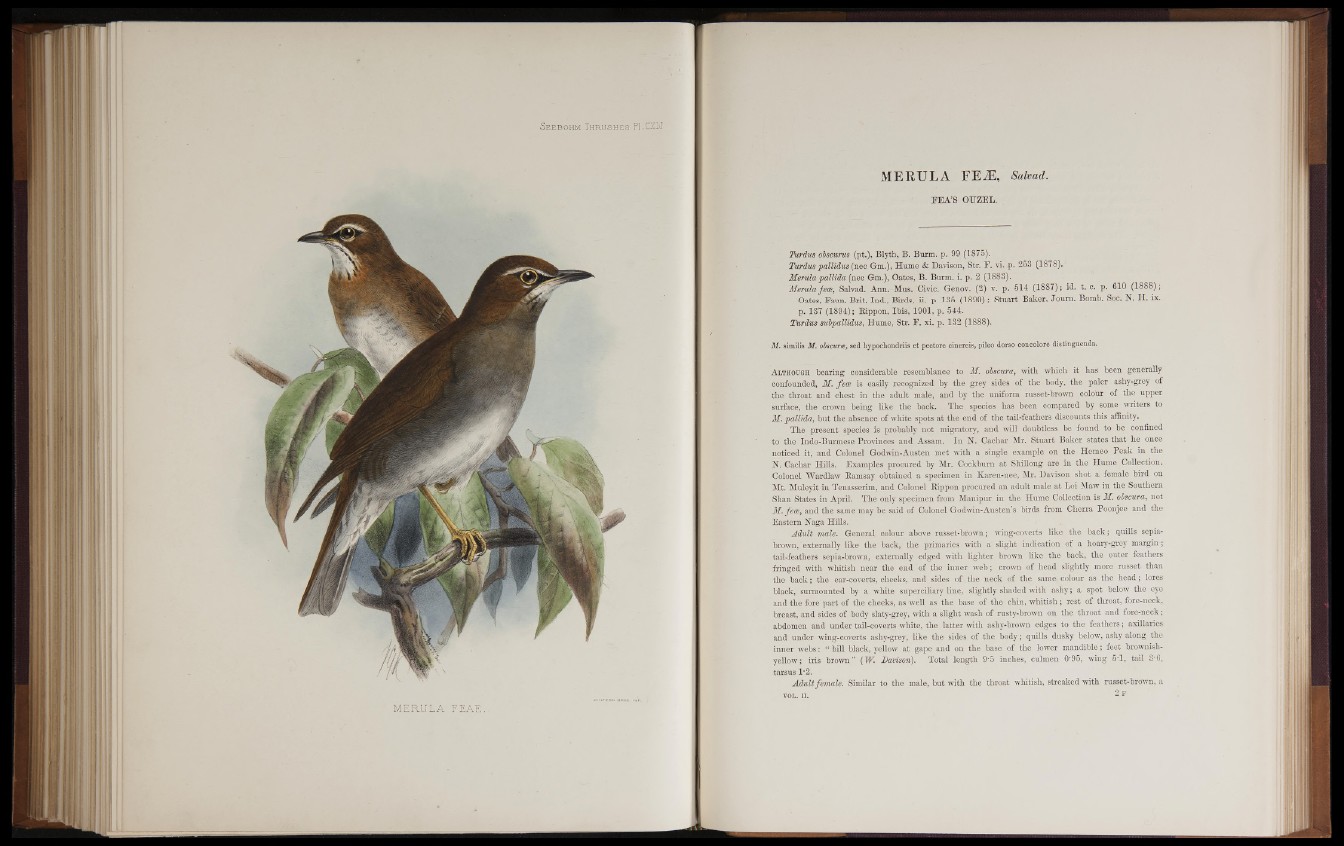
M E R U L A FEJE, Salvad.
PEA’S OUZEL.
Turdus obscurus (pt.), Blyth, B. Burm. p. 99 (1875).
Turdus pallidus (nee Gm.), Hume & Davison, Str. F. vi. p. 253 (1878). *
Merula pallida (nec Gm.), Oates, B. Burm. i. p. 2 (1883).
Merula fees, Salvad. Ann. Mus. Civic. Genov. (2) v. p. 514 (18§7); id. t. c. p. 610 (1888),
Oates, Faun. Brit. Ind., Birds, ii. p. 135 (1890); Stuart Baker, Journ. Bomb. Soc. N. H. ix.
p. 137 (1894); Rippon, Ibis, 1901, p. 544.
Turdus subpallidus, Hume, Str. F. xi. p. 132 (1888).
M. similis M. obscures, sed hypochondriis et pectore cinereis, pileo dorso concolore distinguenda.
A lthough bearing considerable resemblance to M. obscura, with which it has been generally
confounded, M. few is easily recognized by the grey sides of the body, the paler ashy-grey of
the throat and chest in the adult male, and by the uniform russet-brown colour of the upper
surface, the crown being like the back. The species has been compared by some writers to
M. pallida, but the absence of white spots at the end of the tail-feathers discounts this affinity.
The present species is probably not migratory, and will doubtless be found to be confined
to the Indo-Burmese Provinces and Assam. In N. Cachar Mr. Stuart Baker states that he once
noticed it, and Colonel Godwin-Austen met with a single example on the Hemeo Peak in the
M. Cachar Hills. Examples procured by Mr. Cockburn at Shillong are in the Hume Collection.
Colonel Wardlaw Ramsay obtained a specimen in Karen-nee, Mr. Davison shot a female bird on
Mt. Muleyit in Tenasserim, and Colonel Rippon procured an adult male at Loi Maw in the Southern
Shan States in April. The only specimen from Manipur in the Hume Collection is M. obscura, not
M. few, and the same may be said of Colonel Godwin-Austen’s birds from Cherra Poonjee and the
Eastern Naga Hills. J
Adult male. General colour above russet-brown; wing-coverts like the back; quills sepia-
brown, externally like the back, the primaries with a slight indication of a hoary-grey margin;
tail-feathers sepia-brown, externally edged with lighter brown like the back, the outer feathers
fringed with whitish near the end of the inner web; crown of head slightly more russet than
the back; the ear-coverts, cheeks, and sides of the neck of the same? colour as the head; lores
black, surmounted by a white superciliary line, slightly shaded with ashy; a spot below the eye
and the fore part of the cheeks, as well as the base of the chin, whitish; rest of throat, fore-neck,
breast, and sides of body slaty-grey, with a slight wash of rusty-brown on the throat and fore-neck;
abdomen and under tail-coverts white, the latter with ashy-brown edges to the feathers; axillari.es
and under wing-coverts ashy-grey, like the sides of the body; quills dusky below, ashy along the
inner webs: “ bill black, yellow at gape and on the base of the lower mandible; feet brownish-
yellow; iris brown” (IV. Davison). Total length 9*5 inches, culmen 0'95, wing 5T, tail o*6,
tarsus 1*2.
Adult female. Similar to the male, but with the throat whitish, streaked with russet-brown, a
vol. i i . 1 1